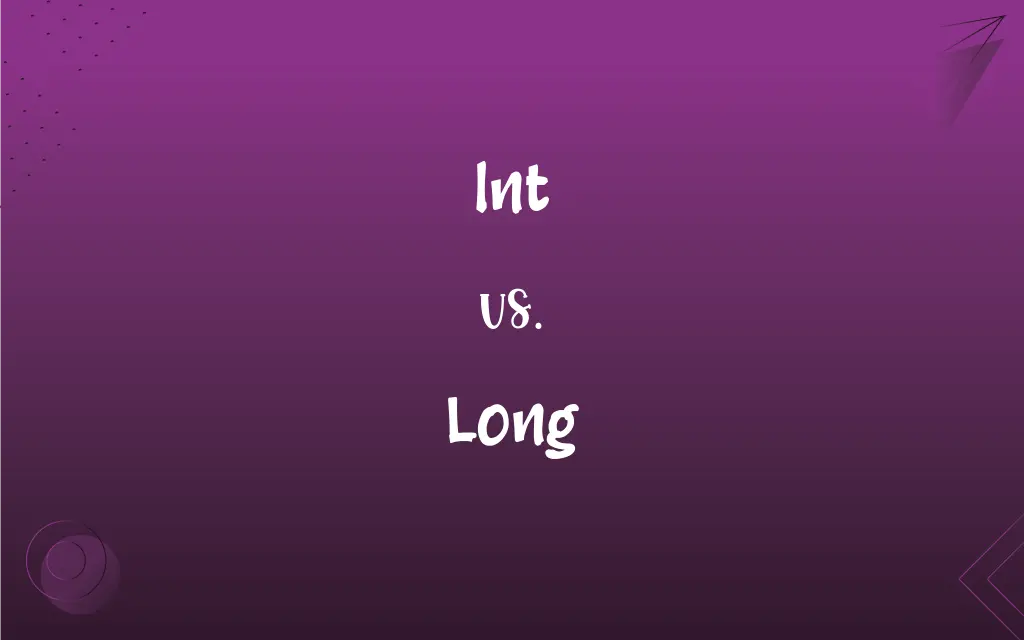Int vs. Long: What's the Difference?
Edited by Aimie Carlson || By Janet White || Published on February 2, 2024
Int (Integer) is a data type representing whole numbers within a specific range, typically smaller than long, which represents larger whole numbers with a wider range.

Key Differences
Int, short for integer, is a data type in programming that represents whole numbers. A standard int typically occupies 32 bits in memory, offering a range from -2,147,483,648 to 2,147,483,647. Long, on the other hand, is an extended form of integer data type, often occupying 64 bits, which allows it to store much larger numbers, ranging from -9,223,372,036,854,775,808 to 9,223,372,036,854,775,807.
In the context of computer memory and processing, int is more efficient when dealing with numbers within its range. It consumes less memory and can be processed faster than long. Long, due to its larger size, is more memory-intensive and potentially slower in processing but is essential when dealing with numbers beyond the int range.
When it comes to programming languages like Java, int is often the default choice for numerical operations unless a larger range is explicitly needed. Long is specifically used when the calculations or data being processed are expected to exceed the limits of int, thereby preventing overflow errors.
Int is adequate for many everyday programming tasks, such as counting items, indexing arrays, and simple mathematical operations. Long becomes crucial in applications like financial calculations, scientific computations, and situations where high precision and a larger range are required.
From a beginner's perspective, int is usually the go-to data type for whole numbers, due to its simplicity and efficiency. Long is introduced as they progress into more complex tasks requiring larger numerical ranges, ensuring accurate and error-free computations in such scenarios.
ADVERTISEMENT
Comparison Chart
Memory Size
Typically 32 bits
Typically 64 bits
Numeric Range
-2,147,483,648 to 2,147,483,647
-9,223,372,036,854,775,808 to 9,223,372,036,854,775,807
Usage Scenario
General-purpose for smaller numbers
Large numbers beyond the int range
Efficiency
More efficient in memory and processing
Less efficient due to larger size
Programming Example
Indexing in arrays, simple counters
Financial calculations, scientific computations
ADVERTISEMENT
Int and Long Definitions
Int
In mathematics, int symbolizes a non-decimal number.
The function returned an int value of 5.
Long
Long refers to an extended length or duration.
We went on a long journey.
Int
Int is used to represent non-fractional numbers in computing.
The loop iterates 10 times, controlled by an int counter.
Long
In programming, long is a data type for large whole numbers.
The variable 'bigNumber' was declared as a long.
Int
Int is an abbreviation for integer, a whole number.
The array index must be an int.
Long
Long can describe something of great extent or scope.
The long wall stretched across the city.
Int
Int, in database terms, is a field for storing integers.
The database column 'age' is of type int.
Long
Long is used to express a desire or wish for something.
She longed for a chance to visit Paris.
Int
In programming, int refers to a data type for storing whole numbers.
The variable 'count' was declared as an int.
Long
As an adverb, long means for an extended time period.
He waited long for the news.
Long
Extending or traveling a relatively great distance.
Long
Having relatively great height; tall.
FAQs
When is long necessary?
Long is necessary for handling numbers beyond the range of int.
What is an int?
An int is a data type for storing whole numbers within a specific range.
When should I use int?
Use int for general-purpose programming with smaller numerical values.
Is int faster than long?
Yes, int is generally faster and more memory-efficient than long.
Can long be used in place of int?
Technically yes, but it's not efficient for small numbers.
What is a long?
A long is a data type for storing larger whole numbers than an int.
How much memory does an int use?
An int typically uses 32 bits of memory.
How much memory does a long use?
A long usually occupies 64 bits of memory.
Do all programming languages support int and long?
Most modern programming languages support these data types.
Can int store decimal values?
No, int can only store whole numbers.
Can int and long be interchanged?
They can be, with caution to avoid overflow or truncation errors.
Why is long less efficient than int?
Due to its larger size, it consumes more memory and can be slower in processing.
Is long default in any programming languages?
No, int is usually the default; long is used specifically when needed.
Is long used in mathematical computations?
Yes, especially where high precision and large numbers are involved.
Can int and long store negative values?
Yes, both can store negative values.
What happens when int overflows?
It typically wraps around to the minimum value.
Can I convert int to long and vice versa?
Yes, with type casting, but be mindful of the value range.
Are int and long different in all programming languages?
Their specifics can vary, but the general concept is consistent across languages.
Are int and long signed or unsigned?
In most languages, both are signed by default.
What is the literal suffix for long in C++?
It's 'L' or 'l', as in 123L.
About Author
Written by
Janet WhiteJanet White has been an esteemed writer and blogger for Difference Wiki. Holding a Master's degree in Science and Medical Journalism from the prestigious Boston University, she has consistently demonstrated her expertise and passion for her field. When she's not immersed in her work, Janet relishes her time exercising, delving into a good book, and cherishing moments with friends and family.
Edited by
Aimie CarlsonAimie Carlson, holding a master's degree in English literature, is a fervent English language enthusiast. She lends her writing talents to Difference Wiki, a prominent website that specializes in comparisons, offering readers insightful analyses that both captivate and inform.































































